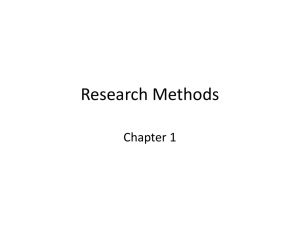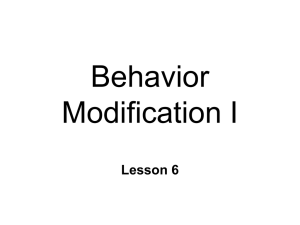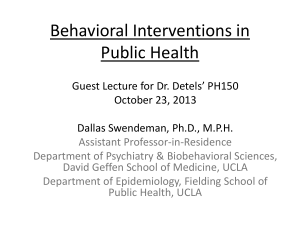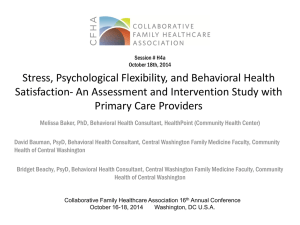The Primary Care Behavioral Health Model
advertisement
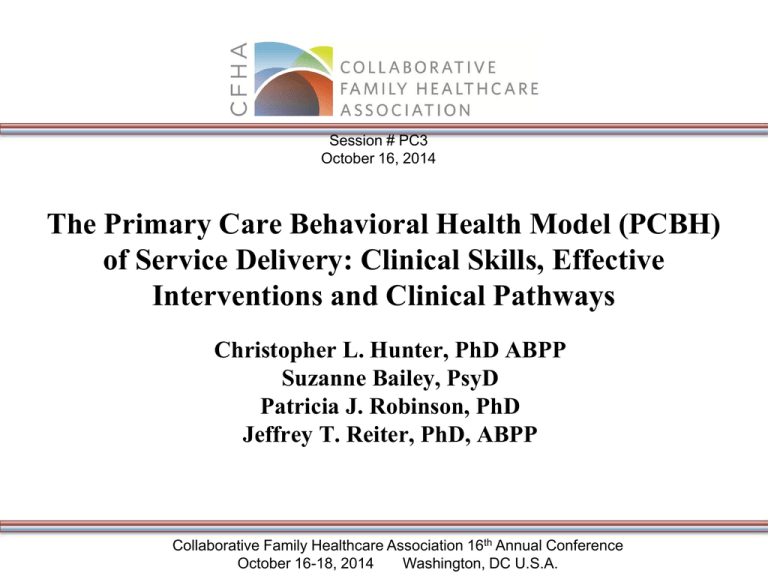
Session # PC3 October 16, 2014 The Primary Care Behavioral Health Model (PCBH) of Service Delivery: Clinical Skills, Effective Interventions and Clinical Pathways Christopher L. Hunter, PhD ABPP Suzanne Bailey, PsyD Patricia J. Robinson, PhD Jeffrey T. Reiter, PhD, ABPP Collaborative Family Healthcare Association 16th Annual Conference October 16-18, 2014 Washington, DC U.S.A. Faculty Disclosure • We have not had any relevant financial relationships during the past 12 months. Learning Objectives At the conclusion of this session, the participant will be able to: Learning Objectives: ● List the primary content areas for core competency development ● Describe 4 evidence-based primary care BH interventions for adults and children. ● Discuss at least 1 evidence-based clinical pathway that would work in most health systems. Practice Tools: 1. Know how to use the 5As paradigm to efficiently & effectively deliver evidencebased care. 2. Will have evidence-based assessment & intervention strategies for effective adult, child & adolescent primary care behavioral health service delivery. 3. Understand what clinical pathway processes they can implement & how to effectively implement them to improve the population impact of service delivery. 2014 Annual Conference Core Competencies Patricia J. Robinson, PhD Jeffrey T. Reiter, PhD, ABPP Primary Care Behavioral Health Model Behavioral Health Consultant Core Competency Skills* 2014 Annual Conference I. Clinical Practice Skills II. Practice Management Skills III. Consultation Skills IV. Documentation Skills V. Team Performance Skills VI. Administrative Skills *Robinson & Reiter, 2014. Behavioral Consultation and Primary Care, 2nd Edition Primary Care Behavioral Health Model Behavioral Health Consultant Work Sample Clinic: What To Expect ● Variety of methods for getting pt to the BHC ○ Before PCP ○ PCP and BHC in room together ○ After PCP ● Variety of problems and ages ○ Clinical (MH, SA, Beh Med, all ages) ○ Case management/Care coordination ● Variety in the goals of visits ○ PCP-Prep ○ Treatment augmentation ○ Medication and treatment planning. Primary Care Behavioral Health Model 2014 Annual Conference Sample Clinic Complexity and Diversity ● 9:00 PCP wants meds rec ○ 52 y/o homeless, ? ADHD vs bipolar ● 9:30 Question re disability expiring ○ 64 y/o Russian-speaker, depression ● 10:00 PCP says “I don’t know her problem” ○ 62 y/o, psychiatrist d/c’d, on 3 meds from 3 Drs ● 10:30 Open→WH w/ PCP in exam room ○ 12 y/o autism, ADHD, recently showing tics, hall’s Primary Care Behavioral Health Model 2014 Annual Conference Sample Clinic Complexity and Diversity 2014 Annual Conference ● 11:00 N/S→WH in exam room, PCP- prep ○ 6 y/o ADHD, insomnia, enuresis ● 11:30 Planned f/u from 1 week earlier ○ 20 y/o Spanish-speaker, depressed w/ SI ● 1:00 Team mtg (15-min talk on pain, 5-min on tobacco cessation) ● 2:00 Cx→same-day appt for NRT refill Primary Care Behavioral Health Model Sample Clinic Complexity and Diversity 2014 Annual Conference ● 2:30 Open→WH for CSA ○ 60 y/o severe etoh, chronic arm pain ● 3:00 Planned f/u after 2 weeks ○ 47 y/o homeless, MDD w/ psychosis, acute SI due to meds ● 3:30 Planned f/u after 1 month ○ 45 y/o homeless, MDD, trying to get disability ● 4:00 Cx→WH for PCP prep on new pt ○ 16 y/o expelled from school, needs risk assessmt ● 4:30 Open→Same-day f/u after 4 mos ○ 20 y/o seeking disability for PTSD, dep Primary Care Behavioral Health Model 2014 Annual Conference The 5A’s An Operational Heuristic Christopher L. Hunter, PhD, ABPP Primary Care Behavioral Health Model 5A’s-Assess, Advise, Agree, Assist, Arrange Operational Heuristic Diagram adapted from: Glasgow, R. E & Nutting, P. A. (2004). Diabetes. In Handbook of Primary Care Psychology. Ed., Hass, L. J. (pp. 299-311) 2014 Annual Conference Assess Risk Factors, Behaviors, Symptoms, Attitudes, Preferences Advise Arrange Specify plans for follow-up (visits, phone calls, mail reminders) Specific, personalized, options for tx, how sx can be decreased, functioning, quality of life/health improved Personal Action Plan 1. List goals in behavioral terms 2. List strategies to change health behaviors 3. Specify follow-up plan 4. Share plan with practice team Assist Provide information, teach skills, problem solve barriers to reach goals Agree Collaboratively select goals based on patient interest and motivation to change Primary Care Behavioral Health Model * 5A’s-Assess, Advise, Agree, Assist, Arrange Operational Heuristic 2014 Annual Conference The 5A’s format is “strongly” recommended for assessment and intervention across a range of problems in primary care. Whitlock, Orleans, Pender & Allen (2002). Evaluating primary care behavioral counseling interventions: An evidence-based approach. American Journal of Preventive Medicine, 22, 267-284. Goldstein, Whitlock, & DePue (2004). Multiple behavioral risk factor interventions in primary care: Summary of research evidence. American Journal of Preventive Medicine, 27(Suppl 2), 61-79. Primary Care Behavioral Health Model 5A’s-Assess, Advise, Agree, Assist, Arrange Operational Heuristic 1. 2014 Annual Conference Introduction of behavioral health consultation service (1-2 minutes) 2. Identifying/Clarifying consultation problem (10-60 seconds) Assess 3. Conducting functional analysis of the problem (12-15 minutes) 4. Summarizing your understanding of the problem (1-2 minutes) 5. Listing out possible change plan options (selling it) (1-2 minutes) Advise Agree 6. Starting a behavioral change plan (5-10 minutes) Assist Arrange Primary Care Behavioral Health Model 5A’s-Assess, Advise, Agree, Assist, Arrange Operational Heuristic 2014 Annual Conference Assess Phase Introduction ● Purpose: the appointment ○ Tell Them Your Profession ○ Consultant Role ○ Structure of Appointment ○ Who will have what access to information gathered Primary Care Behavioral Health Model 5A’s-Assess, Advise, Agree, Assist, Arrange Operational Heuristic Assess Phase Functional Assessment ● Referral Question Clarification ○ Problem (Duration, Intensity, Frequency) ○ What Makes Problem Better or Worse ● ○ ○ ○ ○ ○ What is the Functional Impairment Work, Performance or Relationships Family Relations Social Activities Recreational Activities Exercise Primary Care Behavioral Health Model 2014 Annual Conference 5A’s-Assess, Advise, Agree, Assist, Arrange Operational Heuristic Assess Phase Functional Assessment (continued) ● Changes In: ○ Sleep ○ Energy ○ Concentration, Appetite ● Risk Assessment ○ Suicidal Ideation ○ Homicidal Ideation ○ Thoughts of Death Primary Care Behavioral Health Model 2014 Annual Conference 5A’s-Assess, Advise, Agree, Assist, Arrange Operational Heuristic Assess Phase Functional Assessment (continued) ● ● ● ● ● ● 2014 Annual Conference Caffeine Consumption TOB Consumption ETOH Consumption OTC Medication or Supplements What does a Typical Work Day Look Like What does a Typical Week-End Look Like Patient Ideas on Behavioral Goals ● BHC asks patient what one or two things they have control of that if they changed would improve functioning or decrease symptoms Primary Care Behavioral Health Model 5A’s-Assess, Advise, Agree, Assist, Arrange Operational Heuristic Assess Phase Problem Summary (1-2 minutes) ● ● Clarifies the patient’s presenting problem Builds empathy Primary Care Behavioral Health Model 2014 Annual Conference 5A’s-Assess, Advise, Agree, Assist, Arrange Operational Heuristic 2014 Annual Conference Advise Phase ● Give clear, specific & personalized change advice ● Changes the pt might make & how those changes might be beneficial Primary Care Behavioral Health Model 5A’s-Assess, Advise, Agree, Assist, Arrange Operational Heuristic 2014 Annual Conference Agree Phase Collaboratively Select Goals ● Find common ground & define behavior change & goals ● Shared decision making = Greater sense of personal control Choices based on realistic expectations Change matches patient values Primary Care Behavioral Health Model 5A’s-Assess, Advise, Agree, Assist, Arrange Operational Heuristic 2014 Annual Conference Assist Phase ● Develop and implement a specific tailored action plan ○ Plan should: 1. Help identify, address and overcome barriers 2. Develop self-management skills 3. Develop confidence to successfully change Primary Care Behavioral Health Model 5A’s-Assess, Advise, Agree, Assist, Arrange Operational Heuristic 2014 Annual Conference Arrange Phase ● Review goals ● Provide additional interventions ● Follow-up plan ○ Create easy return access ○ If pt is to f/u with community provider, bridge the gap...prevents pts falling through the cracks! Primary Care Behavioral Health Model 2014 Annual Conference Primary Care Interventions With Adults Suzanne Bailey, PsyD Primary Care Behavioral Health Model Primary Care Interventions with Adults 2014 Annual Conference Overview ● ● ● Essential Components of Interventions Intervention Framework Population-based Interventions in Primary Care ○ Substance Use ○ Depression Primary Care Behavioral Health Model Interventions with Adults: Essential Components 2014 Annual Conference ● Brief Encounters ● Emphasis on Self-Management ● Focus on Functional Outcomes ● Flexible Follow-up ● Liaison with Specialty Services Primary Care Behavioral Health Model Essential Components: Brief Encounters 2014 Annual Conference ● Brief redefined ○ 15-30 minute visits ○ Limited number of contacts ○ Episodes of care within context of longitudinal PC relationship ● Multiple change agents ● Patient is the primary agent of change ● Capture teachable moments Primary Care Behavioral Health Model Essential Components: Emphasis on Self-Management 2014 Annual Conference ● The patient is your guide ● Support with strategies ● Monitor level of engagement and motivation for change ● Provide behavioral rehearsal & resources Primary Care Behavioral Health Model Essential Components: Focus on Functional Outcomes 2014 Annual Conference ● Target improved functioning ● Symptom reduction is not the only target ● Follow the referral question ● Outcomes are measurable Primary Care Behavioral Health Model Essential Components: Flexible Follow-up 2014 Annual Conference ● Intervention unified and congruent with overall primary care plan ● Intervention plan is dynamic and evolves based on ongoing assessment of symptoms, functioning, engagement, & motivation ● Flexible scheduling and follow-up strategies ● Conjoint and coordinated appointments Primary Care Behavioral Health Model Essential Components: Liaison with Specialty Services 2014 Annual Conference ● Primary care is first line ● Triage ● Psychoeducation about treatment options ● Build motivation and engagement ● Facilitate access and coordinate care ● Reabsorption Primary Care Behavioral Health Model Interventions with Adults: Framework 2014 Annual Conference ● Framework ● Define a Target ● Conduct Brief Intervention ● Assess Response to Intervention ● Develop Follow-up Plan ● Coordinate Care Primary Care Behavioral Health Model Framework: An Initial BHC Visit 2014 Annual Conference Robinson & Reiter, 2014. Behavioral Consultation and Primary Care: A Guide to Integrating Services. See Chapter 9. Primary Care Behavioral Health Model Define a Target 2014 Annual Conference ● Follow PCP referral ● Assess symptoms, functioning, and health behaviors ● Defined target focuses brief interventions Primary Care Behavioral Health Model Strategic Reframe 2014 Annual Conference ● Distill core elements into a workable problem ○ Restate, reflect, refocus ● Be mindful of context, but stay focused on target ● Mirror and model the process ● Prioritize Primary Care Behavioral Health Model Target Conceptualization Context Features of Effective Brief Interventions ● Solution focused ● ● Targets specific behavior change ● ● Active and empathic ● therapeutic style ● ● Support increase in quality and meaning in life 2014 Annual Conference Incorporate patient values and beliefs Measurable outcomes Enhance self-efficacy Patient responsible for change Primary Care Behavioral Health Model Effective Brief Interventions ● Relaxation Skills ● Cognitive Therapy Strategies ● ACT Strategies ● Motivational Interviewing ● Mindfulness Strategies ● Behavioral Structure and Hygiene 2014 Annual Conference ● ● ● ● ● ● ● Goal Setting Problem Solving Skills Behavioral Activation Stimulus Control Communication Skills Exercise Solution Focused Strategies Primary Care Behavioral Health Model Factors to Consider ● ● ● ● ● ● Patient preference Symptom severity Readiness to change Level of engagement Psychosocial stressors Co-morbid conditions 2014 Annual Conference ● ● ● ● ● Cultural beliefs Resources Health status Health beliefs Health literacy Primary Care Behavioral Health Model Assess Response to Intervention 2014 Annual Conference ● Monitor level of motivation and confidence ● Monitor symptoms and functioning ● Active problem-solving ● Discuss obstacles ● Review and reinforce progress Primary Care Behavioral Health Model Follow-up Plan Options Close (1-2 weeks) • Severity & acuity of problem 2014 Annual Conference Intermediate (1 month) • Clinical needs of patient • Overall primary care plan With PC Visits, PRN, or None • Level of motivation and engagement • Clinical needs of patient Primary Care Behavioral Health Model Care Coordination Options Face-to-Face 2014 Annual Conference Phone • Visit type & timing • Clinical needs of patient • Severity & acuity of problem • Overall primary care plan EHR • Overall primary care plan • Clinical needs of patient Primary Care Behavioral Health Model Application: Population-Based Interventions 2014 Annual Conference ● Substance Use ● Depression Primary Care Behavioral Health Model 2014 Annual Conference Substance Use: Motivational Interviewing Primary Care Behavioral Health Model Target: Substance Use ● ● ● ● ● ● ● ● ● ● 2014 Annual Conference Enhance motivation to change Use values to develop discrepancy Provide psychoeducation Identify strategies to avoid or cope with triggers Build coping skills Identify positive social supports and activities Provide self-help resources (AA/NA) Collaboratively develop a relapse prevention plan Coordinate referral to more intensive treatment Build motivation for engagement more intensive treatment Primary Care Behavioral Health Model 2014 Annual Conference Depression: Behavioral Activation Primary Care Behavioral Health Model Target: Behavioral Activation 2014 Annual Conference ● Increase patient engagement in activities that provide enjoyment and sense of accomplishment ● Behave first, feel later ○ “Outside-In” ● Act according to plan or goal, not feeling Primary Care Behavioral Health Model Behavioral Activation in Primary Care 2014 Annual Conference ● Step 1. Rationale. ○ Explain that when we feel down, we sometimes stop doing many activities that we used to like to do ● Step 2. Select activities that increase and sense of mastery ○ Ask the patient about activities they used to enjoy and any activities they already do but would like to do more often ○ Ask if there is something that they need to do they’ve been avoiding ● Step 3. Review, Reinforce, Reset ○ In follow up visits, the BHC reviews progress on goals, reinforces progress, problem-solves barriers to progress, and resets goals as needed. Primary Care Behavioral Health Model 2014 Annual Conference Primary Care Interventions With Children and Adolescents Patricia J. Robinson, PhD Primary Care Behavioral Health Model * 2014 Annual Conference Primary Care Behavioral Health Model Pediatric PCBH Services: SUPPORT Study 2014 Annual Conference 1. Significant increase identification of psychiatric, health-related, or phase of life problems among children 2. Significant increase in pediatrician documentation of behavioral issues addressed 3. Significant increase in appointment show rate among SUPPORT participants compared to non-participants 4. Parent/child satisfaction with SUPPORT services 5. Significant increase in child functioning as measured by Child Behavior Checklist Pediatric Quality of Life School Grades & Attendance Primary Care Behavioral Health Model Aims & Objectives 2014 Annual Conference 6. Significant decrease in hospitalization/breathing problems among children with asthma/respiratory disorders. 7. Significant decrease in weight & body mass index among obese children. 8. Significant decrease in Hemoglobin A and Fasting Blood Sugar (FBS) among children with diabetes. 9. Significant decrease in office visits and school absence among children with multiple somatic complaints. Primary Care Behavioral Health Model Provider Satisfaction 2014 Annual Conference ● One month after implementation of Overall Clinical Skills Mean Satisfaction by Region SUPPORT, Pediatricians and office staff were very satisfied with Sample the overall clinical skills of the Region Size Mean SUPPORT therapist. Ft. Worth (Cook Children’s) 52 1.48 ● Also, 74.5% strongly agreed that Dallas (Parkland) 40 1.22 integration of the BH provider San Antonio 50 1.32 enhanced the practice’s efficiency. Lubbock 7 1.00 El Paso 34 1.38 Valley 18 1.06 Mean Range: 1 (very satisfied) to 5 (very dissatisfied) Primary Care Behavioral Health Model Clinical Improvements for Multiple Problems 2014 Annual Conference Children 18 months to 5 years Significantly fewer problems on the Child Behavior Checklist at 3-month F-U Primary Care Behavioral Health Model Clinical Improvements for Multiple Problems 2014 Annual Conference Children 6 – 18 years Significantly fewer problems on the Child Behavior Checklist at 3-month follow-up Primary Care Behavioral Health Model Components of an Initial BHC Visit 2014 Annual Conference Robinson & Reiter, 2014. Behavioral Consultation and Primary Care: A Guide to Integrating Services. See Chapter 9. Primary Care Behavioral Health Model · Interview & Intervention Skills Life Context Questions for Children and Teens (see pdf) 2014 Annual Conference Functional Analysis Questions (see pdf) Primary Care Behavioral Health Model A Great Intervention for Adolescents & Adults Bulls Eye Plan: Prevention & Intervention ● ● ● ● 2014 Annual Conference Values Clarification Values Connection Approach (not avoidance) Perspective taking (observer stance) ● Supports on-going planning ● Involves SMART goals See Robinson, Gould, & Strosahl, 2010. ● Encourages PCMH team support of Real Behavior Change in Primary Care: committed health promoting Improving Outcomes and Increasing actions over time Satisfaction Primary Care Behavioral Health Model RX Pad for PCBH Team: Preventive and On-Going Management of Chronic Pain 2014 Annual Conference Your Clinic Your Phone Number Love Work Play Plan: _________________________________________________ ______________________________________________________ ______________________________________________________ Primary Care Behavioral Health Model FACT Worksheet ● ● ● ● 2014 Annual Conference Overview of worksheet Role Play set up During role play, use Worksheet as if you were the BHC After role play, work with partner: Conceptualize powerful interventions Is patient clear about values? connected to values? Engaged in life? Accepting of challenges? Able to defuse? Can shift from participant to observer perspective? Primary Care Behavioral Health Model Components of A Follow-Up BHC Visit 2014 Annual Conference Primary Care Behavioral Health Model 2014 Annual Conference Clinical Pathways Christopher L. Hunter, PhD ABPP Patricia J. Robinson, PhD Jeffrey T. Reiter, PhD, ABPP Primary Care Behavioral Health Model * 2014 Annual Conference Clinical Pathways: The Military Health System Christopher L. Hunter, PhD ABPP Primary Care Behavioral Health Model Military Health System 2014 Annual Conference What Is A Clinical Pathway? ● ● ● ● Method of pt screening/assessment/intervention for a well-defined group of people States the goals and key elements of care Based on Evidence Based Medicine guidelines, best practice and patient expectations by facilitating the communication, coordinating roles and sequences of multidisciplinary care team activities. Goal is to improve quality of care, reduce risks, increase pt satisfaction and increase the efficiency in the use of resources Primary Care Behavioral Health Model Military Health System 2014 Annual Conference ● ● ● ● Developed by behavioral health and physician PCMH leads Designed to increase use of BHCs as part of standard care Designed to improve pt outcome & pt & PCP satisfaction with care 9 Pathways developed ○ ○ ○ ○ ○ ○ ○ ○ ○ Alcohol Misuse Anxiety Depression Diabetes Obesity Chronic Pain PTSD Sleep Problems Tobacco Use Primary Care Behavioral Health Model 2014 Annual Conference Clinical Pathways: Neurodevelopmental Screening Patricia J. Robinson, PhD Primary Care Behavioral Health Model Neurodevelopmental Screening Pathway 2014 Annual Conference ● Target: Children 18-24 months ● Methods: Exam Room Poster, Well-Child Visits ● Objectives: ○ Increase early screening ○ ○ ○ ○ ○ Increase child and family access to BHC services Address behavioral concerns at primary care level as possible Improve relationships with community partners Provide earlier referrals to community resources Improve parent satisfaction See PDFs: M-CHAT EXAM ROOM POSTER N-D Dev Pathway Statement Template for charting ASQ Primary Care Behavioral Health Model 2014 Annual Conference Clinical Pathways: Chronic Pain Jeffrey T. Reiter, PhD, ABPP Primary Care Behavioral Health Model Overview: Chronic Pain and Opioids 2014 Annual Conference ● Participants: Patients considered for long-term opioid treatment ● Goals: ○ improve functioning ○ decrease opioid abuse ● Core Pathway Components: ○ Initial risk assessment stratifies care protocol ○ Process for regular CSA, planned UDS ○ Group/class substitutes for PCP visit Primary Care Behavioral Health Model Assessing Risk of Medication Abuse 2014 Annual Conference ● Commonly used paper-and-pencil screens ○ SOAPP, ORT ○ Aberrant behavior checklist ● Urine drug screen (UDS) at 1st visit—matches hx? ● Substance use hx ● Review old records ○ Problems w/ past Drs? Inconsistent history? Primary Care Behavioral Health Model Controlled Substance Agreements (CSA) 2014 Annual Conference ● Purposes of a CSA ○ Decrease: abuse/diversion, self-dosing, urgent pt calls, conflicts w/ staff, early RF ○ Increase: discussion about meds issues, PCP satisfaction ● Components of a helpful agreement ○ Education, conditions for RF, functional goals ● Important to use routinely (not after a problem is suspected) Primary Care Behavioral Health Model Group Workflow ● ● ● ● ● ● ● ● 2014 Annual Conference Weekly class, different time each week PCPs notified in advance of patients attending Check-in begins 30 mins prior to group Lab tech obtains UDS BHC conducts group for 45 mins Pts return to lobby BHC checks UDS results, confers with PCP as needed Pts retrieved for brief PCP visit for refill only Primary Care Behavioral Health 2014 Annual Conference QUESTIONS? Primary Care Behavioral Health Model Bibliography / Reference 2014 Annual Conference 1. Hunter, C. l., Goodie, J. l., Oordt, M. S. & Dobmeyer, A. C. (2009). Behavioral Health in primary care: A practitioners handbook. Washington, DC: American Psychological Association 1. Nash, J. M., Khatri, P., Cubic, B. A., Baird, & Macaran, A. (2013). Essential competencies for psychologists in patient centered medical homes. Professional Psychology: Research and Practice, Vol 44(5), 331-342. 1. Robinson, P. J., & Reiter, J. D. (2014). Behavioral Consultation in Primary Care: A Guide to Integrating Services. NY: Springer. 1. Robinson, P. J., Gould, D. A., & Strosahl, K. (2011). Real Behavior Change in Primary Care: Improving Outcomes and Increasing Job Satisfaction. Oakland: New Harbinger. 1. Strosahl, K. D., Robinson, P. J., & Gustavsson, T. (2012). Brief Interventions for Radical Change. Oakland: New Harbinger. Learning Assessment • A learning assessment is required for CE credit. • A question and answer period will be conducted at the end of this presentation. Session Evaluation 2014 Annual Conference Please complete and return the evaluation form to the classroom monitor before leaving this session. Thank you!

